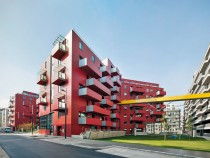
© Gerhard Hagen
Despite the gradual liberalization of public housing and the termination of domestic construction in 2004, the city of Vienna has managed, with the aid of subsidies, to keep its grip on a large part of housing production. Only a few years before the millennium, when various model schemes sparked off discussions of new topics like the car-free city, housing for women and everyday situations, and when instruments like the council for building sites and competitions for developers were implemented with a view to improving quality, conditions seemed to be opportune for new ideas.
Population growth was only moderate or even stagnating, so that predictions for the year 2021 remained modest with an overall population of approximately 1.7 million. This level has long been reached, however. Present estimates are for 1.9 million in 2020, and 2030 should see the 2 million mark exceeded. After years of stagnation, the city is beginning to recover the self-confidence of a metropolis.
At the same time, this dynamic development and the stress it occasions may have an effect on the customary »Gemütlichkeit«. Some 8,000–11,000 new housing units are needed every year, it is calculated. This, together with the economic crisis, high land prices and increasing construction costs, means poor conditions for upholding Vienna’s much acclaimed social housing system. (Franziska Leeb)
Population growth was only moderate or even stagnating, so that predictions for the year 2021 remained modest with an overall population of approximately 1.7 million. This level has long been reached, however. Present estimates are for 1.9 million in 2020, and 2030 should see the 2 million mark exceeded. After years of stagnation, the city is beginning to recover the self-confidence of a metropolis.
At the same time, this dynamic development and the stress it occasions may have an effect on the customary »Gemütlichkeit«. Some 8,000–11,000 new housing units are needed every year, it is calculated. This, together with the economic crisis, high land prices and increasing construction costs, means poor conditions for upholding Vienna’s much acclaimed social housing system. (Franziska Leeb)





